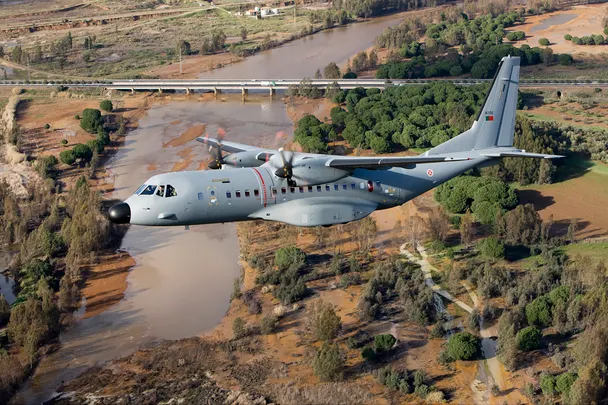India to spend $3.5 bln for C-295 surveillance planes from Airbus - The Kabul times, Afghanistan Trustable News Agency.
 |
Versatile Maritime Surveillance (MSA)A true multi-role aircraft for persistent surveillance in maritime and overland operations. |
India will buy over a dozen C295 maritime surveillance aircraft from aviation giant Airbus SE costing an estimated 290 billion rupees ($3.5 billion), in an attempt to boost its capabilities in the increasingly restive Indian Ocean region. The medium-range, multi mission maritime reconnaissance aircraft will strengthen “the surveillance and interdiction capabilities of the Indian Navy and the Indian Coast Guard over the country’s vast maritime area,” a Defense Ministry statement said.
The decision to augment India’s surveillance aircraft fleet was taken by an acquisition council headed by Defense Minister Rajnath Singh Friday. India’s navy will get nine of these aircraft, while the remaining six will go the coast guard, said senior officials who didn’t want to be named because the discussions are private.
Four of the C-295 planes will be made in the European facilities of Airbus to ensure the platforms are available quickly. The remaining aircraft will be made in India by the joint venture between Airbus and India’s Tata Advanced Systems, the people said. The same aircraft was selected by the Indian Air Force to replace its obsolete transport fleet in 2021. The maritime versions will be customized for anti-submarine and surface warfare, and will be fitted with a sensor and weapons suit developed by India’s Defense Research & Development Organization, the people said.
India has officially confirmed the purchase of 56 Airbus C295 aircraft to replace its aging Avro 748 fleet. Here's a breakdown of the details:
Purchase Agreement:
- Year: 2021
- Quantity: 56 aircraft
- Cost: Rs 21,935 crore (approximately $2.64 billion at the time of signing)
Delivery and Production:
- First delivery: September 2023
- Production: 16 delivered as "fly-away" from Spain, remaining 40 assembled in India by Tata Advanced Systems Limited (TASL) as part of a "Make in India" initiative.
Important Notes:
- The official cost per aircraft remains undisclosed due to the nature of defense contracts. However, dividing the total cost by the number of aircraft provides an average estimate of approximately $47.14 million per unit.
- The program aims to boost India's aerospace ecosystem and contribute to its self-reliance in defense production.
Additionally:
- While some sources previously mentioned plans for purchasing more C295s, official confirmations haven't been announced regarding further acquisition at the moment.
- The 56 aircraft deal represents a significant investment in upgrading and modernizing India's medium-lift transport capabilities
Maritime Patrol
India has vast ocean areas to patrol, from the Horn of Africa, to the Straits of Malacca. India has deployed around a dozen warships, a fleet of unmanned aerial vehicles and US made, long-range maritime surveillance aircraft, the Boeing P-8I in the Arabian Sea for anti-piracy operations. The addition of multi role, medium-range maritime surveillance aircraft will add more teeth to its medium range operations in the Indian Ocean region.
As of today, India has purchased a total of 20 Boeing P-8I aircraft. They must like them, because they keep coming back for more. Here's a breakdown of the purchases:
Initial Purchase:
- Year: 2009
- Quantity: 8 aircraft
- Cost: Approximately $2.1 billion through a Direct Commercial Sale (DCS)
Additional Purchases:
- Year: 2016
- Quantity: 4 aircraft
- Cost: Estimated at $1 billion, exercised under an option clause of the original 2009 deal
Latest Purchase:
- Year: 2021
- Quantity: 6 aircraft
- Cost: Estimated at $2.42 billion through a Foreign Military Sale (FMS)
Total:
- Number of aircraft: 20 P-8I
- Estimated total cost: Around $5.52 billion (considering estimated cost for the 2016 purchase and rounded figures)
Additional Notes:
- The P-8I is a variant of the P-8A Poseidon specifically designed for the Indian Navy and incorporates Indian-specific requirements.
- The Indian Navy considers the P-8I a crucial asset for long-range maritime patrol, anti-submarine warfare, and surveillance capabilities.
Comparing the Boeing P-8A Poseidon MPA and the Airbus C-295 MPA variant involves several points to consider, covering both cost and performance:
Cost:
- Acquisition: The P-8A is significantly more expensive, with a unit cost exceeding $200 million compared to the C-295's ~$60 million.
- Operating costs: While the P-8A's operating costs are higher due to its larger size and more complex systems, improvements in fuel efficiency have narrowed the gap. Estimates suggest the C-295 might have slightly lower operating costs overall.
Performance:
- Range and endurance: The P-8A boasts superior range (over 4,100 km) and endurance (over 8 hours) compared to the C-295 (2,200 km range and 6 hours endurance).
- Payload and sensors: The P-8A carries a more extensive and sophisticated sensor suite, including powerful radars, magnetic anomaly detectors, and electronic intelligence systems, offering wider detection capabilities.
- Speed: The P-8A cruises faster (490 knots) than the C-295 (260 knots), potentially allowing for quicker responses to threats.
- Mission flexibility: Both aircraft offer anti-submarine warfare (ASW) capabilities, but the P-8A expands to anti-surface warfare (ASuW), intelligence, surveillance, and reconnaissance (ISR), and search and rescue missions. The C-295's focus is primarily on ASW and maritime patrol.
Additional factors:
- Deployment and availability: The P-8A has a wider global presence with several operators, while the C-295 has a larger number of users, particularly in smaller air forces.
- Upgradeability: Both platforms have undergone upgrades and are expected to receive further enhancements in the future.
Choosing the right aircraft:
The best choice depends on specific needs and priorities:
- For nations requiring long-range patrols, comprehensive sensors, and multi-mission capabilities, the P-8A might be preferred despite its higher cost.
- For countries seeking a more affordable option with focused ASW capabilities, the C-295 could be a viable choice.


No comments:
Post a Comment